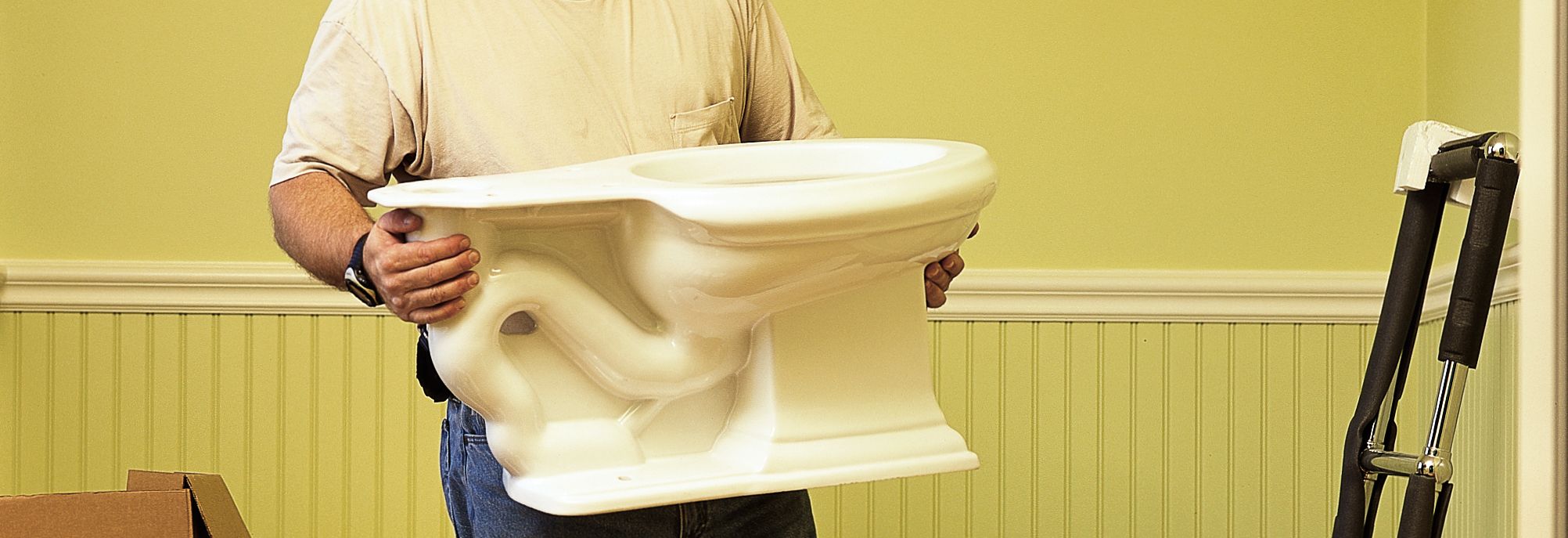Project details
Skill
Cost
Estimated Time
Many homeowners can install a new toilet or replace an old one themselves with the right tools and a little know-how. It may seem daunting initially, but the process is straightforward and can be completed in about four to six hours. Our guide will walk you through installing a toilet, from understanding the basics to troubleshooting common issues.
A Guide to Toilets
Before diving into the installation process, familiarize yourself with the components of a toilet and the different types available. This will help you make informed decisions and lead to a smoother installation.
Parts of a Toilet
A typical toilet has two main parts: the bowl and the tank. The bowl is the lower portion that sits on the floor and houses the seat. The tank, mounted on top of the bowl, holds the water used for flushing. Other important components include the following:
- Closet bolts: Secure the toilet to the floor
- Fill valve: Refills the tank after flushing
- Flapper: Controls the amount of water that goes from tank to bowl during flushing
- Flush valve: Releases water from the tank into the bowl
- Supply line: Connects the toilet to the home’s water supply
- Wax ring: Creates a watertight seal between the toilet and the floor
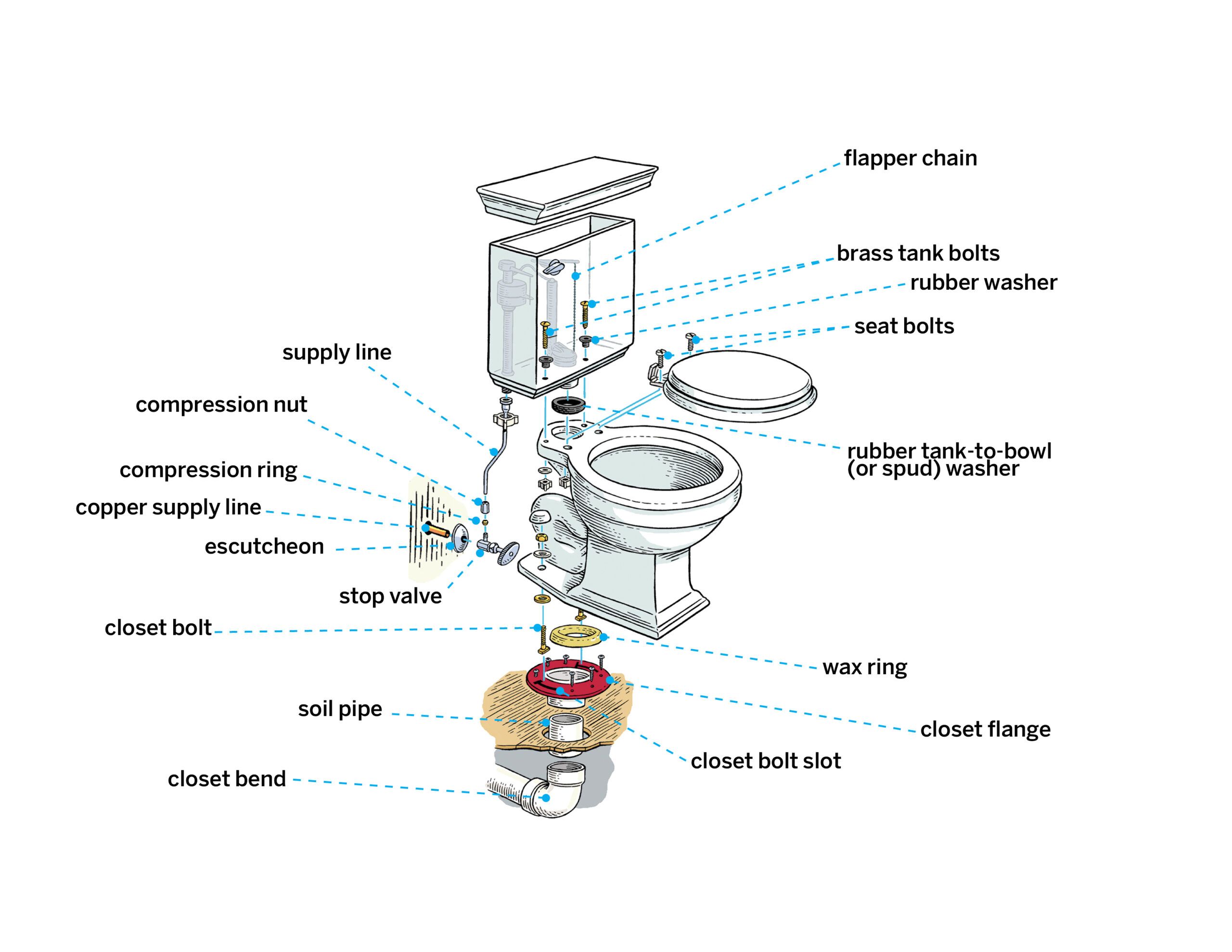
Types of Toilets
There are several types of toilets to choose from, each with its own advantages. Consider factors such as bathroom size, water efficiency, and personal preference when selecting a toilet for your home. Here are just a few of the possible options:
- Two-piece toilets: A common type, with a separate tank and bowl
- One-piece toilets: Sleeker design with tank and bowl molded together
- Wall-mounted toilets: Tank is concealed in the wall, saving floor space
- Dual-flush toilets: Offer two flush options for water conservation
Preparing for Installation of a Toile
Gather all necessary tools and materials before beginning this project.
Tools and Materials Needed to Install a Toilet
To install a toilet, you’ll need the following tools:
- Adjustable wrench
- Brass washers
- Closet bolts
- Electric drill
- Hacksaw
- Level
- New toilet
- Plumber’s tape
- Putty knife
- PVC cement
- PVC primer
- Screwdriver
- Stainless steel screws
- Supply line
- Tape measure
- Wax ring
Safety Considerations
When installing a toilet, keep these safety tips in mind:
- Ensure proper ventilation when using adhesives or solvents
- Keep the work area clean and dry to prevent slips and falls
- Turn off the water supply before starting
- Use proper lifting techniques, as toilets can be heavy
- Wear gloves to protect your hands
Removing the Old Toilet
If you’re replacing an existing toilet, you’ll need to remove it before installing the new one. This process involves disconnecting the water supply and carefully removing the tank and bowl.
Disconnecting the Water Supply
- Locate the shut-off valve near the toilet’s base and use it to shut off the water supply.
- Flush the toilet to empty the tank and bowl.
- Disconnect the supply line from the shut-off valve and the toilet tank.
Removing the Tank and Bowl
- Unscrew the nuts connecting the tank to the bowl and carefully lift off the tank.
- Remove the nuts securing the bowl to the floor and gently rock the bowl to break the wax seal.
- Lift the bowl straight up and set it aside on an old towel or cardboard.
Preparing the Bathroom Floor
Before installing the new toilet, inspect the subfloor and confirm the closet flange is in good condition. These steps will help prevent future leaks and provide a stable installation.
Inspecting the Subfloor
Examine the area around the drain opening for any signs of water damage or rot. If you find any issues, repair them before proceeding with the installation. This may involve replacing damaged flooring or reinforcing the subfloor. Before you begin installing the flange, do the following:
- Stuff a rag into the soil pipe to block sewer gas and prevent hardware from falling in.
- Check that the hole in the floor is large enough to accommodate the closet flange up to its collar. If the hole needs to be enlarged, trace around the flange’s base with a pencil, then cut away the excess flooring with a hacksaw. Don’t cut any joists.
- Dry-fit the soil pipe into the closet bend. Place the flange over the soil pipe, then measure the gap between the bottom of the flange’s collar and the finish floor.
- Remove the soil pipe and use a handsaw to trim it to the measurement in the previous step. Remove burrs by scraping the cut edge with a utility knife.
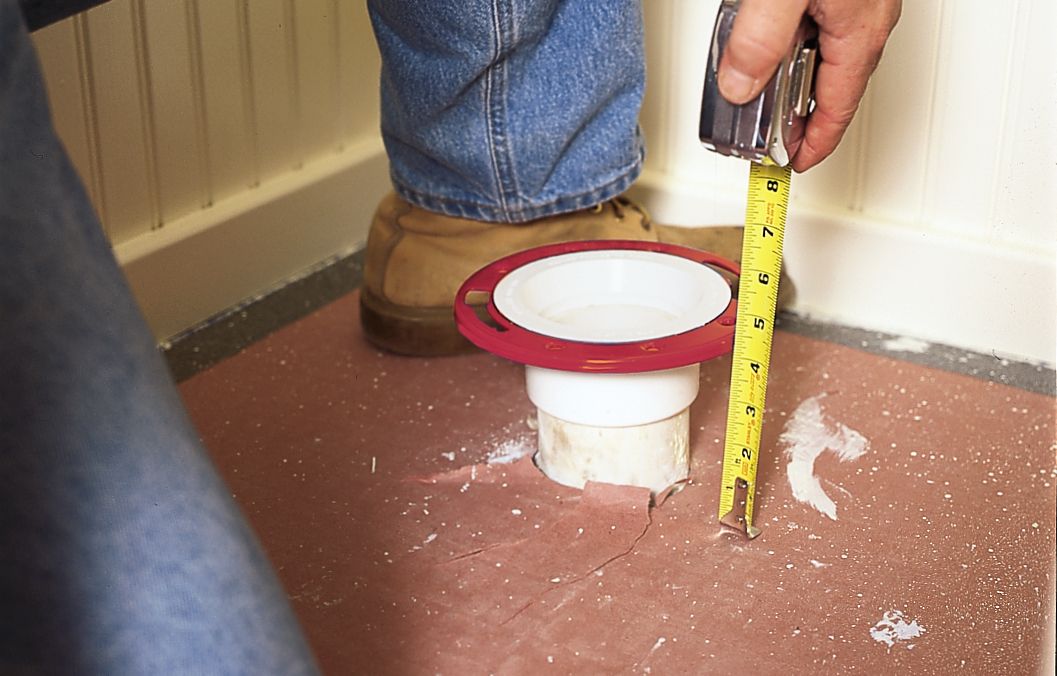
Installing the Closet Flange
The closet flange is an essential component that connects the toilet to the drain pipe. If you’re installing a new toilet in a different location or replacing a damaged flange, follow these steps:
- Wipe PVC primer on the inside of the closet bend and on the outside of one end of the soil pipe. Then, apply PVC cement to those same surfaces and immediately twist the soil pipe into the closet bend.
- Prime and apply cement to the free end of the soil pipe and the inside of the closet flange. Twist and press the flange onto the soil pipe until the collar is seated on the floor.
- Rotate the collar until its slots are positioned to the right and left of the hole. (The closet bolts, which will be inserted into the slots, must line up parallel to the wall behind the tank.)
- Secure the collar to the floor with stainless steel screws long enough to bite into the subfloor.
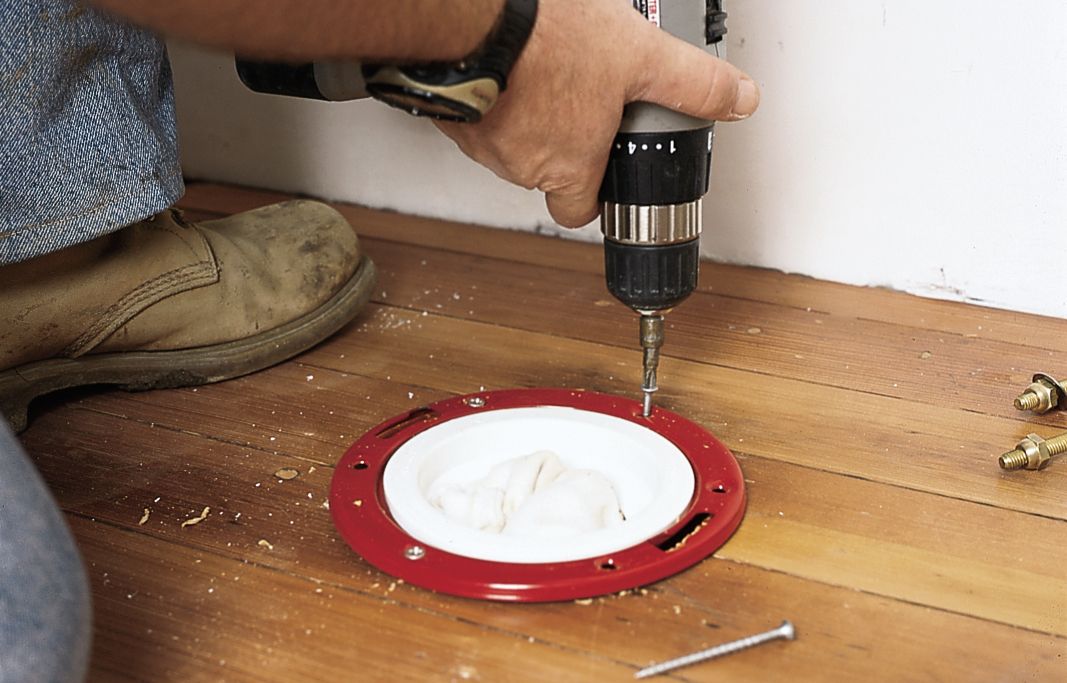
Installing the New Toilet Bowl
With the floor prepared, you can now begin installing the new toilet bowl. This process involves placing the wax ring and carefully positioning and securing the bowl to the floor.
Placing the Wax Ring
- Insert the long brass closet bolts, threaded-end up, into the flange collar’s slots. Slip a brass washer over each.
- Gently press the wax ring, flat-side down, over the flange.
- Lift the toilet bowl over the flange, align the holes in its base with the closet bolts, and lower the base onto the ring.
Positioning and Securing the Bowl
- Carefully lower the bowl onto the closet flange, aligning the holes in the base with the closet bolts.
- Press down firmly on the bowl to compress the wax ring and create a watertight seal.
- Place washers and nuts on the closet bolts and tighten them alternately until the bowl is secure. Be careful not to overtighten, as this can crack porcelain or other fragile materials.
- Use a hacksaw to trim any excess bolt length and snap on the decorative caps.

Attaching the Toilet Tank
Once the bowl is securely in place, you can attach the toilet tank and its components. This involves connecting the tank to the bowl and installing the flush mechanism.
Connecting Tank to Bowl
- Place the large rubber gasket on the underside of the tank, around the flush valve opening.
- Lower the tank onto the bowl, aligning the bolt holes.
- Insert the tank bolts through the holes and secure them with washers and nuts from underneath the bowl.
- Tighten the nuts evenly, alternating between them to ensure a level installation.
Installing the Flush Mechanism
- Install the fill valve and flush valve according to the manufacturer’s instructions.
- Attach the flapper chain to the flush lever, adjusting the length as needed for proper flushing.
- Connect the water supply line to the fill valve using plumber’s tape on the threads to prevent leaks (see below).
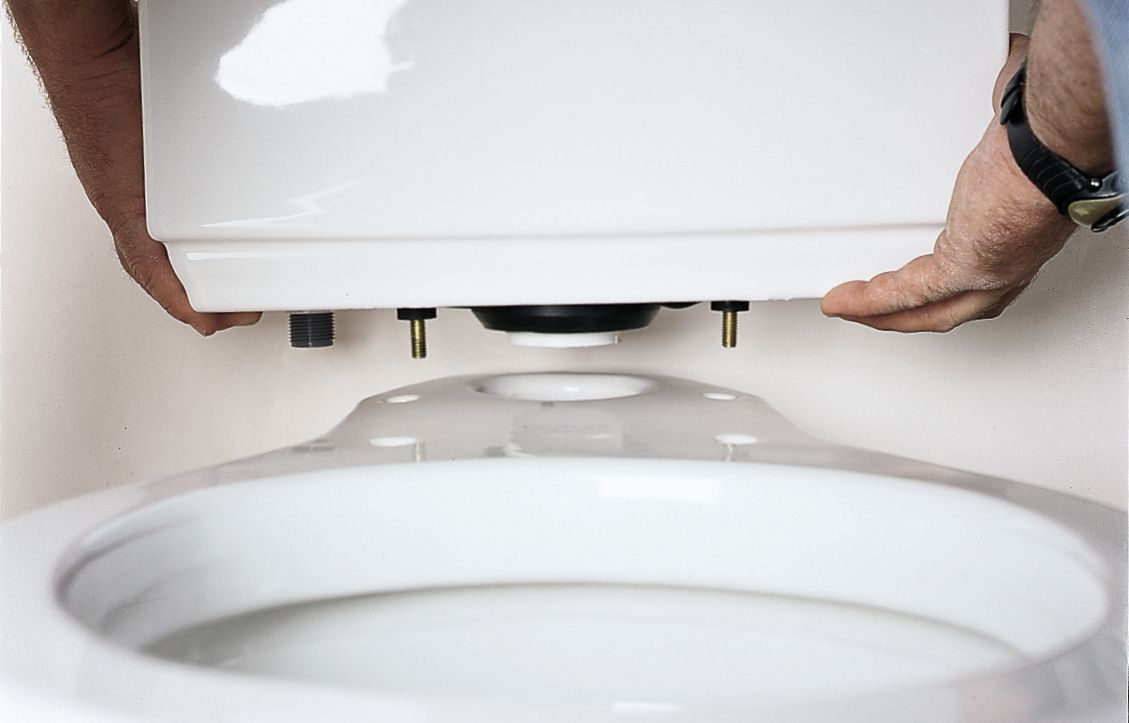
Connecting Water Supply and Testing
With the toilet fully assembled, it’s time to connect the water supply, test for proper function, and look for potential leaks.
Attaching the Supply Line
- Connect the supply line to the shut-off valve using plumber’s tape.
- Hand-tighten the connections, then use an adjustable wrench to give them an additional quarter turn.
- Slowly turn on the water supply and allow the tank to fill.
Checking for Leaks
- Place a dry washcloth or paper towels along the base of the toilet tank. These are used to spot small leaks and to catch the water if a leak is present
- Once the tank is full, flush the toilet and observe all connections for any signs of leakage.
- Check the toilet base for any water seeping out, which could indicate an improperly sealed wax ring.
- If you notice any leaks, tighten connections or reseat the toilet as needed.
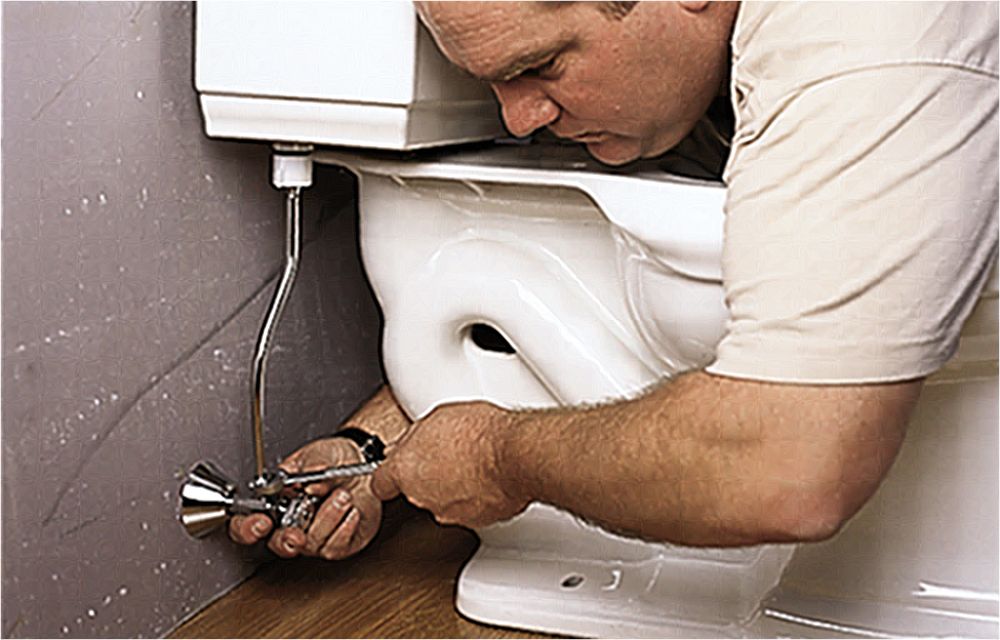
Finishing Touches
To complete the installation, you’ll need to install the toilet seat and caulk around the toilet’s base for a polished look and added stability.
Troubleshooting Common Toilet Installation Issues
Even with careful installation, you may encounter some of the following issues. Here’s how to address them.
Dealing with Uneven Floors
If your bathroom floor is uneven, the toilet may rock or feel unstable. Take these steps to fix it:
- Use plastic shims or additional washers to level the toilet, placing them under the base where needed.
- Trim the shims flush with the toilet base using a utility knife.
- Apply caulk around the base, covering the shims for a seamless look.
Fixing a Rocking Toilet
A rocking toilet can damage the wax ring seal and lead to leaks. Do the following to stabilize it:
- Tighten the closet bolts slightly, alternating between them.
- Add additional shims where necessary.
- Reinstall the toilet, ensuring it’s level and stable before securing it.
Maintaining Your Newly Installed Toilet
Proper maintenance will extend your toilet’s life and help prevent future issues. Here are some tips to keep your toilet in top condition:
Regular Cleaning Tips
- Clean the toilet bowl and tank regularly with a nonabrasive cleaner.
- Use a toilet brush to scrub the bowl, paying extra attention to the rim and under the lip.
- Wipe down the toilet’s exterior, including the base and behind the tank, to prevent dust and grime buildup.
When to Replace Parts
Over time, certain toilet parts may wear out and need replacement:
- Flapper: Replace the flapper valve if you notice constant running or incomplete flushes.
- Fill valve: If the tank doesn’t fill properly or makes unusual noises, it may be time for a new fill valve.
- Wax ring: If you notice water around the base of the toilet, the wax ring may need to be replaced.

Our Conclusion
Installing a toilet is a manageable DIY project that can save money and bring a new look to your bathroom. Follow this guide and take your time with each step. Remember to prioritize safety, use the right tools, and don’t hesitate to call a professional if you encounter difficulties beyond your skill level.
